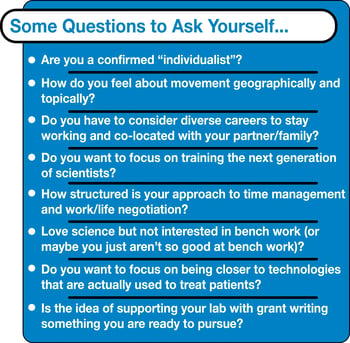One of the less acknowledged perks of scientific and technical training is that these educational paths prepare you for a vast selection of career options. Scientists are certainly following many diverse career paths these days. A recent National Science Foundation study showed that 57% of PhDs in US Biomedical workforce will NOT go into “traditional” academic positions. More recently, I have been hearing exit survey data from postdoctoral programs in the Boston area that demonstrate that 85% of leaving postdocs pursue a career outside the traditional academic silo to tenured professor. Non-academia encompasses millions of choices including pharma, tech transfer, management consulting, science communication, policy and the diverse options in nonprofit science. No one list can ever encompass them all. We can’t designate non-academic jobs as “alternative” anymore.
Since most scientists start out in academia, it is especially important for graduate students and postdocs to get a perspective on other types of science careers as their training progresses. In From Academic Solos to Industrial Symphonies, an article well worth reading on this topic, the authors state, “Both explicit and implicit aspects of today’s postdoctoral training can directly interfere with a seamless jump into industry.”
In his article On Leaving Academe, Terran Lane is asked by his colleagues and friends why he would give up,“an excellent—some say “cushy”—tenured faculty position for the grind of corporate life”. In fact, there are a lot of good reasons to stay and good reasons to go. Here are some questions and perspectives to consider.
What do academic and non-academic careers in science have in common?
- You can do quality science on interesting topics
- Having strong non-science skills is important for success
- Must always justify use of resources and pay attention to budget constraints
- Academic science is much like industry but the “product” is publications—the pressure to produce is the same
- You get to interact with scientists just like you
 What is different about academia?
What is different about academia?
- Publishing in peer reviewed journals is absolutely necessary for success
- One can experience a greater sense of autonomy - there are fewer outside influences on your topics of research or course of action
- One can focus on science for science’s sake
- More opportunity to train and teach students
- Collaborations may be less “complicated” - for example, easy to initiate a collaboration without having to worry about proprietary information
- Work hours are long, but there is more flexibility with the academic calendar
- Academic researchers must be extreme self-starters and especially good at self-promoting—No one is going to tell you to pick up the pace
- Constant worry about grants and renewals
What is different about non-academia?
- Scientific publications are a nice to have, not a need to have
- Must be ready to change projects frequently with little notice or choice
- Always working on a team/in a matrix - can be frustrating for solo flyers
- Other people will routinely scrutinize your data—science can be surprisingly more rigorous in industrial settings
- Tight (sometimes impossible) timelines—others are usually waiting
- Work is concentrated to business hours (mostly), but can often achieve more structured time management conducive to work/life scheduling
- Diverse opportunities to do science related jobs that require no bench work
- Better resources available ($)—can outsource a task someone else who can do better, no grant writing
- Job changes can happen regularly (every 4-6 years is common), but this can also bring new opportunities—projects end and layoffs occur, but good performers move around easily
Table 1: Taking it a Step Further - Big Company v. Small Company
| Big (e.g. Pharma) | Small (e.g. Biotech) |
| Develop expertise areas quickly |
Jack/Jane of all trades |
|
More sources of training and resources within the company |
Must find own sources of knowledge often externally |
| A bit less crazy |
Crazy hours (really) |
| Can have a long term career with advancement in one company, good performers in for the long haul |
Limited movement in one company, likely will need to move around every 3-6 years—a short and exciting ride |
| Complicated matrix structures are common |
Small integrated teams, little hierarchy |
| Real diversity and acceptance can be an issue in getting promoted (especially race and gender) |
Interpersonal issues can create interpersonal issues (one bad apple can change entire culture) |
| Specific requirements for hiring more common |
Likelier to hire on general talent and not specific skills |
| <- Can move between the two (helps to know the right people) -> | |
How can you make a decision about something like this without sufficient data? Starting to learn about the diverse options and how to take advantage of them early is one way to smooth your path to a fulfilling career. Building your network so you can talk to scientists following diverse career paths is an important first step. Developing mentoring relationships, especially with peer mentors, to discuss your strengths, weaknesses, interests and passions is another great way to shed light on what paths to pursue.
Spend some time really thinking about your motivations and what parts of being a scientist you enjoy the most. Having a better idea of where you want to go will help you focus on the transferable skills that you will need to get there.
Additional Resources on the Addgene Blog
- Learn about Possible Science Careers
- How to Negotiate a Successful Lab Start Up Budget
- Read Our Management for Scientists Series
Resources at Addgene.org
- Learn About Careers at Addgene
Topics: Science Careers, Science Career Options







Leave a Comment